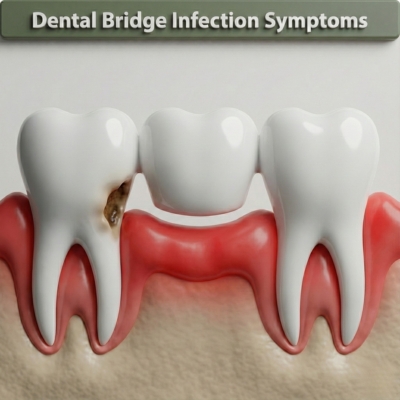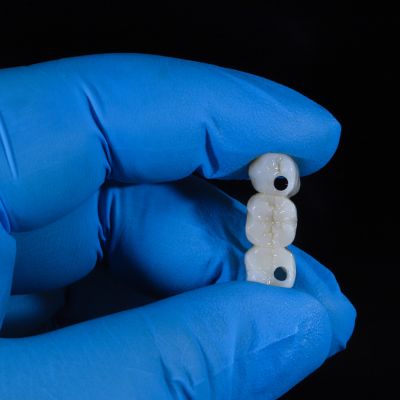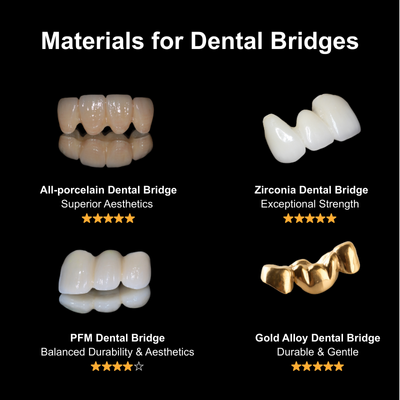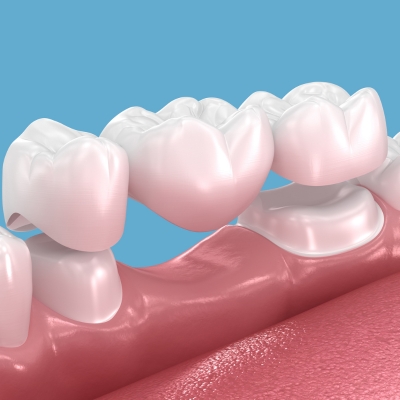News + Articles
7 Signs of a Dental Bridge Infection You Need to Know
Dental bridge infection symptoms typically include throbbing pain, swollen gums, and a persistent foul taste.
This occurs when harmful bacteria build up in the microscopic gaps between your gum line and the restoration, often triggering deep decay or gum disease.
While a dental bridge is designed to protect your smile, an infection underneath it can rapidly compromise the supporting teeth without immediate care.
At Restoration Dental OC, we understand that dental pain triggers anxiety. Our approach focuses exclusively on gentle dental care, ensuring that diagnosing and treating your infection is a comfortable, judgment-free experience.
What Does a Dental Bridge Infection Feel Like? (The Symptoms)
Dental bridge infection symptoms typically start with sensitivity, progressing to throbbing pain, swollen gums, and a persistent foul taste.

Below are the 7 distinct warning signs of an active infection, ordered from the most common early indicators to severe complications.
1. Persistent Throbbing Pain After Dental Bridge
The Sensation: A deep, pulsating ache in the supporting tooth. While normal soreness fades within 3–5 days, this pain persists/continues long after the adjustment period.
The Meaning: Persistent throbbing pain or discomfort is one of the clearest signs that bacteria have reached the nerve or surrounding periodontal tissues.
The Mechanism: Bacterial invasion penetrates the enamel or crown margin and triggers pulp inflammation (irreversible pulpitis), which does not subside on its own.
2. Swollen Gums & Abscess Under Dental Bridge
The Sensation: Red, tender, or swollen gum tissue around the bridge, sometimes accompanied by bleeding during brushing or flossing.
The Meaning: Inflamed gingival tissues indicate that bacteria are accumulating beneath the pontic or along the bridge margins.
Abscess Formation: A pimple-like bump on the gums signals that the infection has traveled deeper to the tooth root or jawbone, requiring urgent care to prevent systemic spread.
3. Dental Bridge Sensitivity to Hot and Cold
The Sensation: Sharp pain when consuming ice-cold drinks or hot foods that lingers for 30 seconds or longer after the stimulus is removed.
The Meaning: Thermal sensitivity suggests the abutment tooth may have developed a cavity beneath the crown, exposing the dentin or nerve to temperature changes.
The Mechanism: Marginal leakage allows bacteria to breach the enamel layer and irritate the pulp chamber.
4. Dental Bridge Pain When Chewing
The Sensation: A sharp or dull ache specifically when chewing or placing pressure on the pontic or abutment teeth.
The Meaning: Chewing pain indicates that the infection may have reached the periodontal ligament, or the bite has become uneven due to inflammation.
The Risk: If untreated, continued bite pressure can traumatize the supporting teeth and worsen the infection.
5. Bad Breath or a Foul, Metallic Taste
The Sensation: Persistent bad breath that brushing or mouthwash cannot eliminate, sometimes accompanied by a sudden unpleasant taste.
The Meaning: This often occurs when bacteria, pus, or decomposing food particles accumulate beneath the bridge or along the margins.
The Mechanism: Anaerobic bacteria break down trapped food and plaque, and this process produces smelly sulfur compounds that cause halitosis.
6. Loose or Ill-Fitting Bridge
The Sensation: The bridge feels unstable, shifts slightly, or no longer fits as snugly as before.
The Meaning: Infection may be weakening the abutment teeth or the surrounding bone, compromising the stability of the entire restoration.
The Consequence: A loose bridge creates larger gaps where bacteria can enter, increasing the risk of recurrent infection and decay.
7. Swollen Lymph Nodes
The Sensation: Tender or enlarged lymph nodes beneath the jaw or along the neck.
The Meaning: This indicates that the body is actively fighting a progressing dental infection, often one involving deep decay or a spreading abscess.
The Mechanism: Bacterial toxins drain into lymphatic tissues, triggering an immune response.
What Causes a Bridge Infection?
Understanding why the infection occurred is crucial for treatment. The gap beneath the pontic (the false tooth replacing your missing teeth) is a prime location for plaque and bacteria to hide.
1. Root Canal Bridge Infection
The most complex cause is a root canal bridge infection. This occurs when the nerve inside the supporting tooth dies due to trauma or deep decay .
Even though the tooth is covered by a crown, the root system underneath can still develop an infection that spreads into the jawbone.
2. Plaque Traps & Poor Hygiene
Plaque accumulation beneath the pontic, if not removed by a floss threader, calcifies into hard tartar (calculus).
This tartar buildup chronically irritates the gum tissue, triggering gum recession that exposes the vulnerable tooth roots to deep bacterial invasion.
3. Ill-Fitting Dental Margins
Over time, the cement holding the bridge can dissolve. This creates a microscopic gap where tooth decay thrives.
An ill-fitting dental bridge acts as a bacterial reservoir that is impossible to clean with a toothbrush alone.
Distinguishing Discomfort: Normal Sensitivity vs. Infection
Patients often ask: “Is my pain normal?” Use this comparison to determine if you need to schedule an appointment.
Feature | Normal Adjustment | Infection Symptom |
Duration | Subsides within 3–5 days | Persists for 5+ days and worsens over time. |
Pain Type | Mild soreness or tenderness | Sharp, throbbing pain, or radiating ache |
Triggers | Biting hard foods | Spontaneous pain (hurts without touching) |
Gum Appearance | Pink or mild temporary redness | Bright red, swollen, or bleeding |
Taste | Normal | Foul taste or bad breath (pus discharge) |
Gentle Treatment Options for Bridge Infections
At Restoration Dental OC, our priority is treating the infection while ensuring your comfort. Our dentistry clinic offers sedation options and a gentle touch to alleviate fear.
Depending on the severity, your treatment plan may include:
1. Antibiotics and Infection Management
If the infection is localized to the gum tissue, a course of antibiotics clears the bacterial presence.
This is often the first step to reduce swelling and pain before further treatment.
2. Root Canal Therapy
If a cavity has reached the nerve of an abutment tooth, a a root canal is necessary to remove the dying nerve while potentially keeping your bridge intact.
The Procedure: We carefully remove the infected pulp, clean the canal, and seal it.
Bridge Preservation: In many cases, we perform this procedure through a small opening in the dental bridge, saving your restoration.
3. Bridge Removal and Replacement
In severe cases where the supporting tooth is compromised, we may need to remove the old bridge to treat the underlying decay effectively.
Once your oral health is restored, we create a new, precision-fit dental bridge designed to seal out bacteria, or discuss dental implants as a permanent, decay-proof solution.
How to Clean Under a Dental Bridge
Standard oral hygiene practices like brushing effectively clean the outer surfaces of your teeth, but they often fail to reach the critical gap between your pontic and the underlying gum tissue.
This hidden area is where plaque biofilm accumulates, leading to the infection symptoms described above.
To prevent bacteria from compromising your abutment teeth (the natural teeth supporting the bridge), you must adopt a specialized hygiene routine using the tools below.
1. Mastering the Floss Threader (or Superfloss)
Because the bridge is fused together, you cannot slide floss down between the teeth as you normally would. You must thread it underneath to disrupt bacterial colonies.
Step 1: Thread. Insert a piece of dental floss through the eye of a floss threader (or use pre-cut Superfloss which has a stiffened end).
Step 2: Insert. Gently guide the rigid end of the threader into the space between the pontic and the gum line until the floss exits on the tongue side.
Step 3: Dislodge. Hold both ends of the floss and slide it back and forth beneath the false tooth. Ensure you gently wrap the floss around the base of the supporting natural teeth to dislodge trapped food particles.
Step 4: Remove. Pull the floss out from one side (do not pull up, as this can loosen the cement).
2. Using a Water Flosser (Oral Irrigator)
For a gentler, touch-free cleaning method, a water flosser utilizes a pressurized stream of water to irrigate the hard-to-reach areas beneath the bridge.
This effectively flushes out food debris and reduces gum inflammation without the need for manual threading.
3. Interdental Brushes
If the gaps between your supporting teeth are wide enough, use a small interdental brush (proxabrush).
Gently insert the brush between the spaces to physically scrub away tartar precursors before they harden.
4. Professional Maintenance
Home hygiene is your first line of defense, but professional care is essential to check the structural integrity of your restoration.
We recommend you visit Restoration Dental OC every 6 months for a comprehensive exam.
During these gentle check-ups, we specifically examine for marginal leakage (gaps where bacteria enter) to ensure your bridge remains secure and infection-free.
Frequently Asked Questions
Can I treat an infection under a dental bridge at home?
No. Home remedies cannot cure the infection. Home remedies like clove oil only mask pain; they do not kill the bacteria. You must see a dentist to physically remove the source of infection and prevent abscess spread.
How long does it take for a dental bridge infection to heal?
Symptoms typically improve within 48 to 72 hours of treatment. However, you must complete the full 7-10 day antibiotic course to fully eradicate the bacterial colony.
Can an infection under a dental bridge spread to the body?
Yes, untreated infections can lead to sepsis. Bacteria from a ruptured abscess can enter the bloodstream, posing serious systemic health risks that require immediate professional care.
Will I need to remove my dental bridge if I have an infection?
Not always; we can often perform a root canal through the bridge. We only remove the bridge if the supporting abutment tooth lacks structural integrity or stability.
What does a bridge infection smell like?
It often smells like rotten eggs or sulfur due to the anaerobic bacteria feeding on trapped food particles.
Don’t Let Pain Linger—Experience Gentle Care Today
Ignoring dental bridge infection symptoms creates a high risk of permanent tooth loss and systemic health complications. However, you do not have to tolerate ongoing pain or anxiety.
Don’t let fear stop you from getting the help you deserve. As a compassionate dentist in Orange, CA, Restoration Dental OC provides Zero-Judgment Exams and sedation options to ensure your path to recovery is completely stress-free.

Dr. Ronald Pham, DDS, is a Doctor of Dental Surgery who graduated from the USC Ostrow School of Dentistry in 2015. With over 8 years of experience in restorative dentistry, including dental implants, crowns, bridges, fillings, root canals…
Dr. Pham has restored the smiles of +2,000 patients and is committed to providing professional dental care focused on patient comfort. He achieves this by combining a welcoming space and state-of-the-art dental technology.
Book Your Appointment Now
Related Articles

Guaranteed Smiles!
As a premiere dentist office in Orange CA, we will always make sure that your experience is memorable, friendly, and professional. We strive to meet your highest expectations in every way imaginable, from your very first interaction with our office staff, to the quality of treatment you receive. We don’t take our patients’ trust for granted, and will promise to over-deliver with your best interest in mind. So give us a call today, and experience our first-class service!
Insurance
Accepted
We proudly accept most dental insurance plans, and welcome cash patients as well. Call us today for more information.
$199
Special
New to our dental office? Take advantage of our New Patient special offer with x-rays, exam, and full report of findings.
Extended
Hours
Do you have an emergency? Need to see us a little later or earlier? Let us know. We can be flexible to meet your busy schedule!










